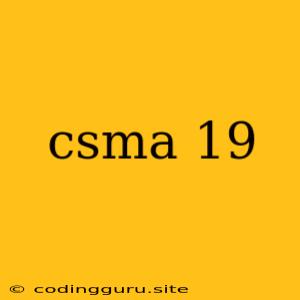Understanding CSMA/CA: How Wireless Networks Avoid Collisions
In the world of wireless networks, where multiple devices share the same airwaves, managing access and preventing collisions is crucial. Enter CSMA/CA (Carrier Sense Multiple Access with Collision Avoidance), a fundamental protocol that enables efficient communication in wireless environments like WiFi.
What is CSMA/CA?
Imagine a busy street with cars trying to cross an intersection. If everyone simply drives into the intersection, chaos and collisions are inevitable. CSMA/CA acts like a traffic controller, establishing rules to ensure smooth and orderly access to the shared medium.
How Does CSMA/CA Work?
CSMA/CA employs a two-step approach to avoid collisions:
- Carrier Sense: Before transmitting, devices listen to the channel to check for ongoing transmissions. This is like cars looking for oncoming traffic before entering an intersection.
- Collision Avoidance: If the channel is busy, devices wait until it becomes free. If multiple devices attempt to transmit at the same time, CSMA/CA uses a mechanism called "backoff" to prevent collisions.
The Backoff Mechanism
Backoff is a randomized delay strategy. When a device detects that the channel is busy, it waits for a random amount of time before attempting to transmit again. This randomization helps to avoid situations where multiple devices try to transmit simultaneously after the channel becomes free.
Key Features of CSMA/CA:
- Distributed Access: CSMA/CA is a decentralized protocol, meaning there's no central authority controlling access. Each device makes its own decisions based on channel conditions.
- Randomized Access: The use of backoff introduces randomness, preventing predictable collision patterns.
- Efficient Use of Bandwidth: By avoiding collisions, CSMA/CA maximizes the use of available bandwidth.
Examples of CSMA/CA in Action:
- WiFi (IEEE 802.11): CSMA/CA is a core protocol for WiFi networks, ensuring reliable data transmission between devices.
- Bluetooth: Bluetooth networks also rely on CSMA/CA to manage communication between connected devices.
Challenges with CSMA/CA:
- Hidden Node Problem: In some scenarios, devices might not be able to "see" each other's transmissions due to obstacles. This can lead to collisions even though both devices believe the channel is free.
- Increased Latency: The backoff mechanism can introduce latency as devices wait for their turn to transmit.
Conclusion
CSMA/CA plays a crucial role in enabling reliable wireless communication by preventing collisions. It provides a mechanism for distributed access and efficient bandwidth utilization. While it has its limitations, CSMA/CA remains an integral part of modern wireless networks.
